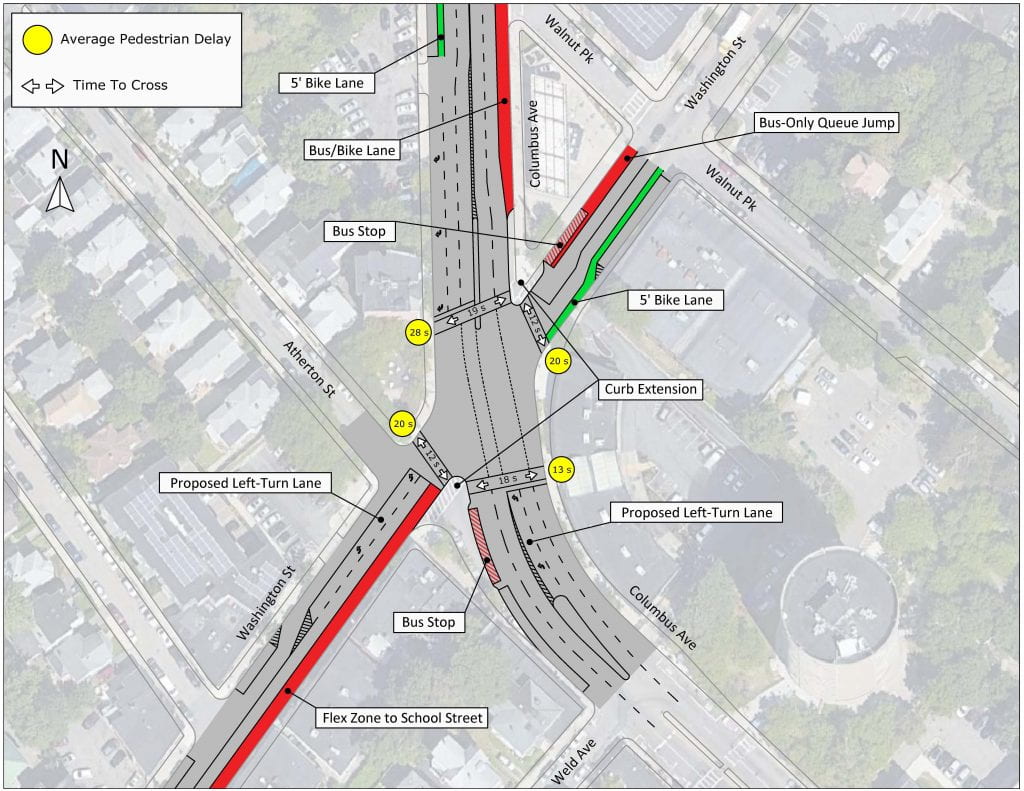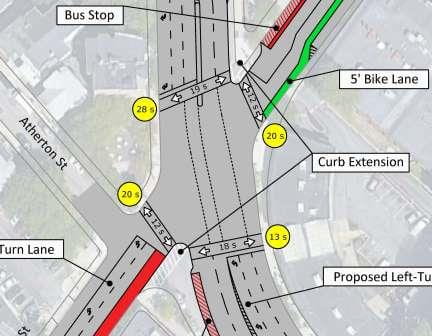Egleston Square is a mess, and so it’s encouraging to see that the City has advanced two concepts for reimagining this intersection (follow this link to see those concepts). Concept 1 focuses on reducing pedestrian crossing distances and waiting times, while Concept 2 focuses on providing bus lanes and bike lanes. The JP Gazette recently ran a poll asking people which they prefer. It turns out you don’t have to choose between these two objectives. Work done by my graduate student Steve Shekari shows we can combine the best features of both concepts, and still add further improvements – an additional bike lane, shorter pedestrian crossings, and shorter pedestrian waiting times. Our design, which I’ll call Concept N (for Northeastern), includes the following features (follow this link to see traffic counts and timing plan for A.M., 1 P.M., and 5 P.M. peak hours): 
- Pedestrian crossing time is reduced by more than 50 percent: the longest crossing is reduced from 140 ft to only 66 ft. For a slow pedestrian (walking pace of 3.5 ft/s), that means needing only 19 seconds to cross the street, compared to 40 seconds today. It’s also a significant improvement over Concepts 1 and 2, whose longest crossing needs 25 seconds to cross. To achieve these short crossings, Concept N adds corner bulbouts in the two tight corners and slightly reorients the crosswalks across Columbus Ave so that they are closer to a right angle. The reoriented crosswalks also give pedestrians better visibility from cars approaching on the curved part of Columbus Ave.
- Pedestrian waiting time is cut by 44 to 74 percent: Average pedestrian delay waiting for a WALK signal is currently 50 seconds (that’s an average; if you arrive at an unlucky time in the signal cycle, your wait could be almost 2 minutes). Concept N reduces that average delay to between 13 and 28 seconds, depending on the crosswalk. This is a huge improvement from what’s there today. (It also appears to be a huge improvement compared to Concepts 1 and 2, but we suspect a calculation error in the Concept 1 and 2 delay estimates.) How is this reduction in waiting time achieved? By shortening the signal cycle; by making the pedestrian crossings concurrent – that is, you’ll cross with the traffic, instead of waiting for a time when all traffic is stopped; and by making the WALK intervals longer, which is possible because the crossings are so much shorter.
- Bike lanes are added. Like Concept 2, the leg of the intersection extending toward Jackson Square gets a southbound bike lane and a northbound combined bus/bike lane, and the Washington Street approach from Forest Hills gets a “flex zone” that could serve as a combined bus / bike lane in the a.m. peak hour. In addition, our design adds a northbound bike lane on the leg of Washington Street that extends towards Dudley Square.
- Bus lanes are added. Like Concept 2, there is a combined bus/bike lane heading toward Jackson Square and a “flex zone” approaching from Forest Hills that can be used as an a.m. peak hour bus/bike lane. And approaching from Dudley Square, our design features a queue jump lane for buses, like Concept 2; however, unlike Concept 2, our queue jump lane ends at the bus stop, about 30 ft before the crosswalk, in order to permit a corner bulb-out that reduces pedestrian crossing distance.
- A left turn lane is provided for northbound Washington Street, making traffic flow more efficient. Making traffic flow “more efficient” may sound like giving priority to motor traffic, but it’s actually vital for pedestrians, bikes, and transit, because that efficiency makes it possible for the intersection to have a small footprint, which is the key to safety and short crossings, and a short signal cycle, which is the key to less delay for pedestrians and buses. Without a left turn pocket, the signal cycle will have to be 120 seconds long, with very long pedestrian delays, and long delays for buses; with it, we can process traffic with a cycle of only 80 seconds in the peak and 75 s midday. This greater efficiency also gives the intersection more reserve capacity, making it less prone to jam when traffic flow is hindered by snow or lane blockages.
- This left turn lane is also a vital safety improvement. The current intersection has a combination of “protected” and “unprotected” left turns for Washington Street northbound. “Protected” means you’re following a green arrow, while “unprotected” means the traffic signal displays only the generic green ball; you have to wait for a gap in opposing traffic, and yield to any pedestrians or bikes who may be crossing. At intersections, unprotected left turns are the main cause of high-speed crashes; they are also the greatest danger faced by pedestrians and cyclists. They are especially dangerous at this intersection because the skew angle allows left turns from Washington Street onto Columbus Ave northbound to be made at high speed. By adding a left turn lane, it becomes possible for all of those left turns to be made in “protected” mode, that is, following a green arrow, with no conflicting traffic.
- A left turn lane is also provided for Columbus Ave northbound traffic. Again, this is a vital safety improvement. It also improves traffic flow efficiency by keeping left-turning cars from blocking through traffic on Columbus Ave.
I had my student Steve Shekari study this intersection because a friend living near Egleston told me how it wasn’t safe for his kids to cross the street. I’m glad to be able to show him what a vast improvement is possible. For the kids, all the other pedestrians, the bike riders, the bus riders, the shoppers, and all the people driving through, I hope we’ll get the see the real improvements on the ground soon. (Written in October, 2018.)
